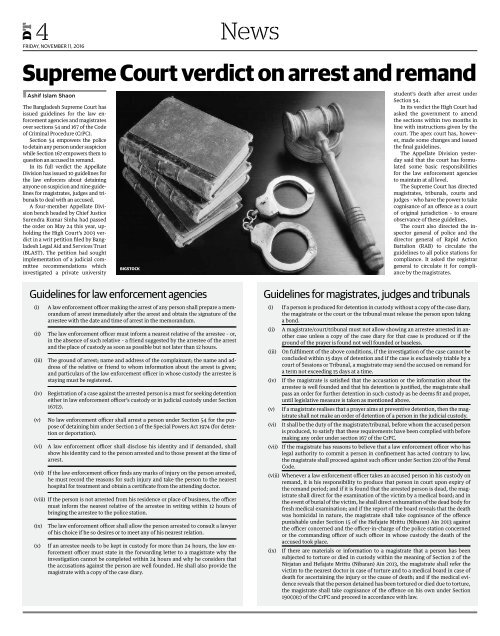e_Paper (11 November 2016)
You also want an ePaper? Increase the reach of your titles
YUMPU automatically turns print PDFs into web optimized ePapers that Google loves.
4<br />
FRIDAY, NOVEMBER <strong>11</strong>, <strong>2016</strong><br />
DT<br />
News<br />
Supreme Court verdict on arrest and remand<br />
• Ashif Islam Shaon<br />
The Bangladesh Supreme Court has<br />
issued guidelines for the law enforcement<br />
agencies and magistrates<br />
over sections 54 and 167 of the Code<br />
of Criminal Procedure (CrPC).<br />
Section 54 empowers the police<br />
to detain any person under suspicion<br />
while Section 167 empowers them to<br />
question an accused in remand.<br />
In its full verdict the Appellate<br />
Division has issued 10 guidelines for<br />
the law enforcers about detaining<br />
anyone on suspicion and nine guidelines<br />
for magistrates, judges and tribunals<br />
to deal with an accused.<br />
A four-member Appellate Division<br />
bench headed by Chief Justice<br />
Surendra Kumar Sinha had passed<br />
the order on May 24 this year, upholding<br />
the High Court’s 2003 verdict<br />
in a writ petition filed by Bangladesh<br />
Legal Aid and Services Trust<br />
(BLAST). The petition had sought<br />
implementation of a judicial committee<br />
recommendations which<br />
investigated a private university<br />
BIGSTOCK<br />
student’s death after arrest under<br />
Section 54.<br />
In its verdict the High Court had<br />
asked the government to amend<br />
the sections within two months in<br />
line with instructions given by the<br />
court. The apex court has, however,<br />
made some changes and issued<br />
the final guidelines.<br />
The Appellate Division yesterday<br />
said that the court has formulated<br />
some basic responsibilities<br />
for the law enforcement agencies<br />
to maintain at all level.<br />
The Supreme Court has directed<br />
magistrates, tribunals, courts and<br />
judges – who have the power to take<br />
cognisance of an offence as a court<br />
of original jurisdiction – to ensure<br />
observance of these guidelines.<br />
The court also directed the inspector<br />
general of police and the<br />
director general of Rapid Action<br />
Battalion (RAB) to circulate the<br />
guidelines to all police stations for<br />
compliance. It asked the registrar<br />
general to circulate it for compliance<br />
by the magistrates.<br />
Guidelines for law enforcement agencies<br />
(i)<br />
(ii)<br />
(iii)<br />
(iv)<br />
(v)<br />
A law enforcement officer making the arrest of any person shall prepare a memorandum<br />
of arrest immediately after the arrest and obtain the signature of the<br />
arrestee with the date and time of arrest in the memorandum.<br />
The law enforcement officer must inform a nearest relative of the arrestee – or,<br />
in the absence of such relative – a friend suggested by the arrestee of the arrest<br />
and the place of custody as soon as possible but not later than 12 hours.<br />
The ground of arrest; name and address of the complainant; the name and address<br />
of the relative or friend to whom information about the arrest is given;<br />
and particulars of the law enforcement officer in whose custody the arrestee is<br />
staying must be registered.<br />
Registration of a case against the arrested person is a must for seeking detention<br />
either in law enforcement officer’s custody or in judicial custody under Section<br />
167(2).<br />
No law enforcement officer shall arrest a person under Section 54 for the purpose<br />
of detaining him under Section 3 of the Special Powers Act 1974 (for detention<br />
or deportation).<br />
(vi) A law enforcement officer shall disclose his identity and if demanded, shall<br />
show his identity card to the person arrested and to those present at the time of<br />
arrest.<br />
(vii) If the law enforcement officer finds any marks of injury on the person arrested,<br />
he must record the reasons for such injury and take the person to the nearest<br />
hospital for treatment and obtain a certificate from the attending doctor.<br />
(viii) If the person is not arrested from his residence or place of business, the officer<br />
must inform the nearest relative of the arrestee in writing within 12 hours of<br />
bringing the arrestee to the police station.<br />
(ix)<br />
(x)<br />
The law enforcement officer shall allow the person arrested to consult a lawyer<br />
of his choice if he so desires or to meet any of his nearest relation.<br />
If an arrestee needs to be kept in custody for more than 24 hours, the law enforcement<br />
officer must state in the forwarding letter to a magistrate why the<br />
investigation cannot be completed within 24 hours and why he considers that<br />
the accusations against the person are well founded. He shall also provide the<br />
magistrate with a copy of the case diary.<br />
Guidelines for magistrates, judges and tribunals<br />
(i) If a person is produced for detention in custody without a copy of the case diary,<br />
the magistrate or the court or the tribunal must release the person upon taking<br />
a bond.<br />
(ii) A magistrate/court/tribunal must not allow showing an arrestee arrested in another<br />
case unless a copy of the case diary for that case is produced or if the<br />
ground of the prayer is found not well founded or baseless.<br />
(iii) On fulfilment of the above conditions, if the investigation of the case cannot be<br />
concluded within 15 days of detention and if the case is exclusively triable by a<br />
court of Sessions or Tribunal, a magistrate may send the accused on remand for<br />
a term not exceeding 15 days at a time.<br />
(iv) If the magistrate is satisfied that the accusation or the information about the<br />
arrestee is well founded and that his detention is justified, the magistrate shall<br />
pass an order for further detention in such custody as he deems fit and proper,<br />
until legislative measure is taken as mentioned above.<br />
(v) If a magistrate realises that a prayer aims at preventive detention, then the magistrate<br />
shall not make an order of detention of a person in the judicial custody.<br />
(vi) It shall be the duty of the magistrate/tribunal, before whom the accused person<br />
is produced, to satisfy that these requirements have been complied with before<br />
making any order under section 167 of the CrPC.<br />
(vii) If the magistrate has reasons to believe that a law enforcement officer who has<br />
legal authority to commit a person in confinement has acted contrary to law,<br />
the magistrate shall proceed against such officer under Section 220 of the Penal<br />
Code.<br />
(viii) Whenever a law enforcement officer takes an accused person in his custody on<br />
remand, it is his responsibility to produce that person in court upon expiry of<br />
the remand period; and if it is found that the arrested person is dead, the magistrate<br />
shall direct for the examination of the victim by a medical board; and in<br />
the event of burial of the victim, he shall direct exhumation of the dead body for<br />
fresh medical examination; and if the report of the board reveals that the death<br />
was homicidal in nature, the magistrate shall take cognisance of the offence<br />
punishable under Section 15 of the Hefajate Mrittu (Nibaran) Ain 2013 against<br />
the officer concerned and the officer-in-charge of the police station concerned<br />
or the commanding officer of such officer in whose custody the death of the<br />
accused took place.<br />
(ix) If there are materials or information to a magistrate that a person has been<br />
subjected to torture or died in custody within the meaning of Section 2 of the<br />
Nirjatan and Hefajate Mrittu (Nibaran) Ain 2013, the magistrate shall refer the<br />
victim to the nearest doctor in case of torture and to a medical board in case of<br />
death for ascertaining the injury or the cause of death; and if the medical evidence<br />
reveals that the person detained has been tortured or died due to torture,<br />
the magistrate shall take cognisance of the offence on his own under Section<br />
190(1)(c) of the CrPC and proceed in accordance with law.


















